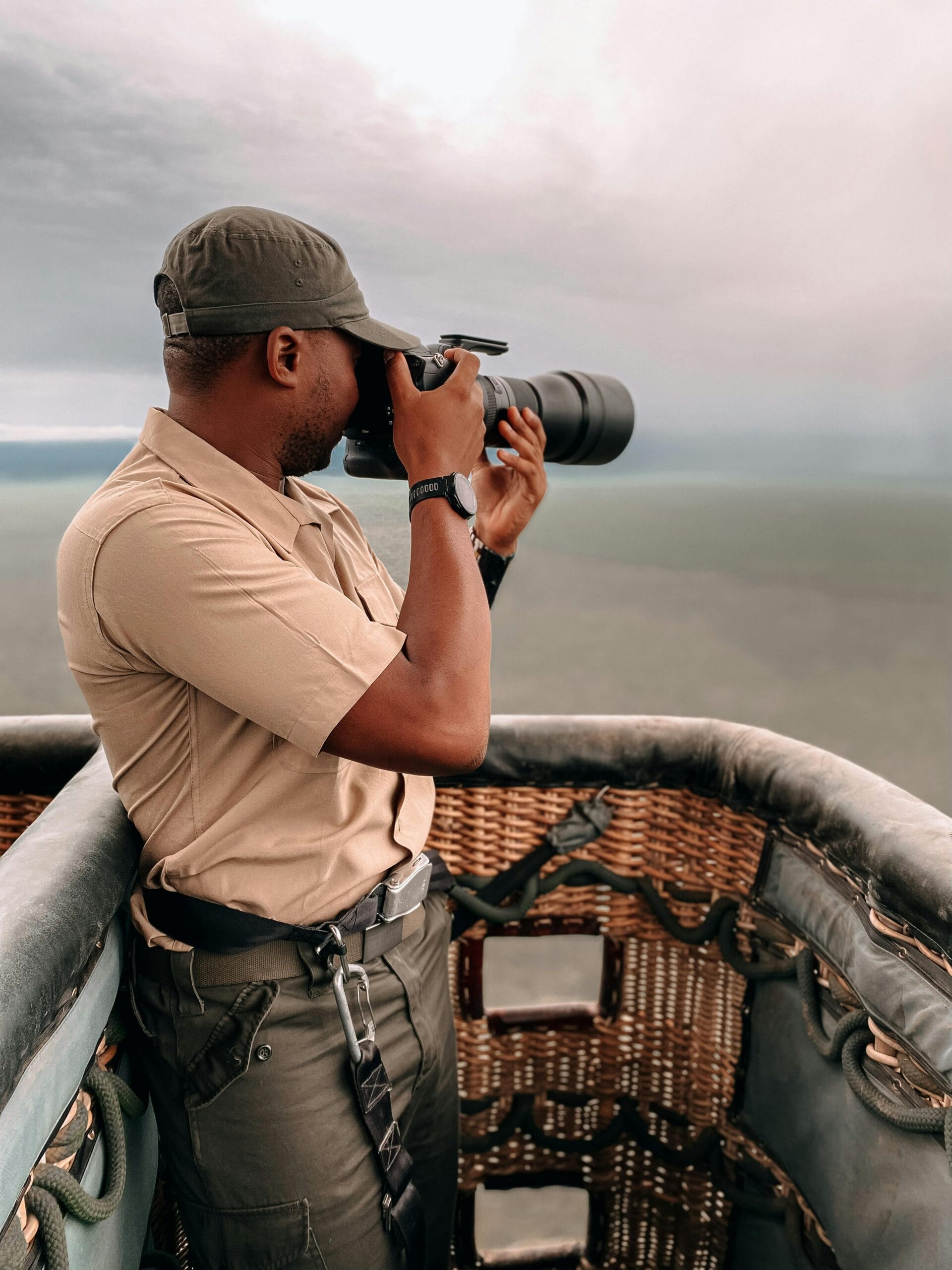A safari in Tanzania offers an incredible opportunity for photographers to capture stunning landscapes, wildlife, and cultural moments. To make sure you’re prepared to take full advantage of the photographic opportunities, it’s essential to pack the right gear and accessories. Here’s a safari packing guide specifically tailored for photographers traveling with Future African Safari.

1. Camera Gear
- Camera Body: A high-quality DSLR or mirrorless camera is essential for safari photography. Consider bringing at least two camera bodies if possible, in case one malfunctions or you need different settings for various shots.
- Lenses:
- Zoom Lens (70-200mm or 100-400mm): A good zoom lens is crucial for capturing wildlife from a distance. The ability to zoom in without disturbing the animals is key to getting the perfect shot.
- Wide-Angle Lens (16-35mm or 24-70mm): A wide-angle lens is ideal for capturing vast landscapes, close-up portraits of wildlife, and the expansive African sky during sunrise or sunset.
- Prime Lens (50mm or 85mm): A fast prime lens is great for capturing sharp, detailed portraits of animals in lower light conditions.
- Telephoto Lens (400mm or longer): If you want to get extreme close-ups of animals, a longer telephoto lens is a great addition to your gear.
2. Tripod and Monopod
- Lightweight Tripod: A compact and sturdy tripod is essential for capturing long exposure shots, particularly in low light conditions like sunrise, sunset, or evening game drives. Make sure it’s lightweight and easy to carry.
- Monopod: A monopod can be a great alternative to a full tripod when you need extra stability but still want mobility during the safari.
3. Camera Accessories
- Spare Batteries: The wildlife will keep you on your toes, so it’s crucial to have extra camera batteries. Safari game drives often last several hours, so bring at least 3-4 spare batteries for long days of shooting.
- Memory Cards: Bring multiple memory cards (32GB or higher). Wildlife photography can generate large files, and you don’t want to run out of storage in the middle of an exciting moment.
- Lens Cleaning Kit: Dust and dirt are inevitable, especially in the African wilderness. Carry a lens cleaning cloth, blower, and cleaning solution to keep your gear in top condition.
- UV or Polarizing Filters: A UV filter can protect your lens from dust and scratches, while a polarizing filter helps reduce glare and enhances the colors of the sky and foliage.
4. Protective Gear
- Camera Bag: Choose a padded, water-resistant camera bag to protect your gear. A bag with easy access is important for quickly grabbing your camera between animal sightings.
- Rain Cover: The weather in Tanzania can change quickly. A rain cover for your camera bag and gear is essential in case of unexpected showers.
- Lens Caps and Covers: Protect your lenses when not in use to avoid scratches and dust.
5. Personal Gear
- Binoculars: A good pair of binoculars will allow you to spot wildlife from a distance, helping you prepare for the perfect shot.
- Headlamp or Flashlight: A headlamp is particularly useful for early morning game drives or nighttime photography. It frees up your hands and provides hands-free lighting.
- Water Bottle: Stay hydrated while you’re out on long game drives, especially in the heat of the day. A reusable water bottle will help you do so sustainably.
6. Power Solutions
- Portable Power Bank: To keep your camera batteries charged when you’re on the go, especially during long drives where charging opportunities may be limited.
- Car Charger/Adapter: Ensure you have a charger for your camera batteries that works in the vehicle for those long days of travel.
7. Clothing and Footwear
- Neutral-Colored Clothing: Wear comfortable, breathable clothing in neutral tones like khaki, olive, and beige. This helps you blend into the environment and not distract the wildlife.
- Hat and Sunglasses: Protect yourself from the sun with a wide-brimmed hat and sunglasses.
- Comfortable Footwear: You’ll be walking and moving through various terrains, so ensure your shoes are comfortable and durable. Hiking boots or sturdy sneakers are ideal.
8. Other Essentials
- Notebook and Pen: If you’re tracking specific animals or wildlife behavior, a notebook can help you document your sightings and photographic ideas.
- Safari Guidebook or App: A guidebook can help you identify animals, birds, and plants, making it easier to anticipate which wildlife to focus on for the perfect shot.
9. Health and Safety Items
- Insect Repellent: Mosquitoes and other bugs are common in Tanzania, especially during the rainy season. Pack a strong insect repellent to avoid bites.
- First Aid Kit: A small first aid kit is essential for handling minor injuries or ailments during your safari.
- Sunscreen: Protect your skin from the harsh African sun with a high SPF sunscreen. Don’t forget to apply it regularly.
10. Travel and Documents
- Passport and Visa: Ensure your passport is up to date and meet the visa requirements for Tanzania before traveling.
- Travel Insurance: Comprehensive travel insurance that covers medical emergencies, trip cancellations, and photography gear damage or theft is essential.
Final Thoughts
A safari is a photographer’s dream, and with the right gear, you can capture every magical moment of your adventure in Tanzania. From the vast savannahs of the Serengeti to the wildlife-rich landscapes of Ngorongoro Crater, packing thoughtfully will ensure you’re prepared for whatever comes your way. With Future African Safari, you’re guaranteed a well-organized and unforgettable journey. Be sure to pack everything you need to document your adventure and bring home memories you’ll treasure forever!

